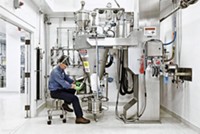Advertisement
Grab your lab coat. Let's get started
Welcome!
Welcome!
Create an account below to get 6 C&EN articles per month, receive newsletters and more - all free.
It seems this is your first time logging in online. Please enter the following information to continue.
As an ACS member you automatically get access to this site. All we need is few more details to create your reading experience.
Not you? Sign in with a different account.
Not you? Sign in with a different account.
ERROR 1
ERROR 1
ERROR 2
ERROR 2
ERROR 2
ERROR 2
ERROR 2
Password and Confirm password must match.
If you have an ACS member number, please enter it here so we can link this account to your membership. (optional)
ERROR 2
ACS values your privacy. By submitting your information, you are gaining access to C&EN and subscribing to our weekly newsletter. We use the information you provide to make your reading experience better, and we will never sell your data to third party members.
Pharmaceuticals
Peptide drugs
October 23, 2006
| A version of this story appeared in
Volume 84, Issue 43
Sept. 18, page 16. Vitamin C was incorrectly identified as citric acid. It is ascorbic acid.
Oct. 9, page 12. The article on brain chemistry should have included the following reference information for the work cited: Science 2006, 314, 130.
The tides may by changing for peptide-based drugs, but it is hard to believe this premise based on the article "Changing Tides" (C&EN, July 17, page 23). While the article does a good job in reviewing advances in peptide manufacturing methods enabling increased capacities and cost efficiencies, the drivers behind these advancements are anecdotal. In the Phase III pipeline table, five of the 20 drugs listed are either newer formulations (insulin, calcitonin) or a new indication (leuprolide) of peptide drugs that have been on the market for many years.
This hardly reflects a robust pipeline of peptide-based drugs advancing as antimicrobial agents, vaccines, immunomodulatory compounds, radiopharmaceuticals, and imaging agents, to name a few. Advances in technologies to synthesize peptide-based compounds with increased stability and in vivo half-life, as well as improved drug delivery methods, have contributed to burgeoning activity in this field.
Carolyn L. Orthner
Birmingham, Ala.




Join the conversation
Contact the reporter
Submit a Letter to the Editor for publication
Engage with us on Twitter